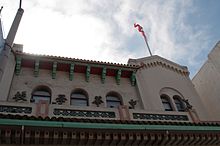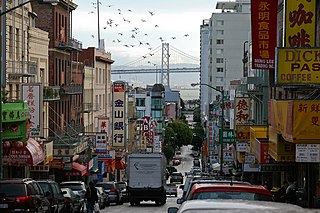History

The Chinese arriving in San Francisco, primarily from the Taishan and Zhongshan regions as well as Guangdong province of mainland China, did so at the height of the California Gold Rush, and many worked in the mines scattered throughout the northern part of the state. [3] Chinatown was the one geographical region deeded by the city government and private property owners which allowed Chinese people to inherit and inhabit dwellings. The majority of these Chinese shopkeepers, restaurant owners, and hired workers in San Francisco Chinatown were predominantly Hoisanese and male [ citation needed ]. Many Chinese found jobs working for large companies, most famously as part of the Central Pacific [4] on the Transcontinental Railroad. Other early immigrants worked as mine workers or independent prospectors hoping to strike it rich during the California Gold Rush.
Although many of the earlier waves of Chinese immigration were predominantly men searching for jobs, Chinese women also began making the journey towards the United States. The first known Chinese woman to immigrate was Marie Seise who arrived in 1848 and worked in the household of Charles V. Gillespie. [5] Within a matter of months of Seise's arrival to the West Coast, the rush for gold in California commenced which brought a flooding of prospective miners from around the globe. Among this group were Chinese, primarily from the Guangdong Province, most of whom were seafarers who had already established Western contacts. “Few women accompanied these early sojourners, many of whom expected to return from after they made their fortune.” [6]
Although the oceanic voyage to the United States offered new and exciting opportunities, dangers also loomed for women while traveling and many were discouraged from making the trip due to the harsh living conditions. Oceanic voyages with Chinese immigrants boarded the Pacific Mail Steamship Company and Canadian Pacific Steamship Company. Chinese immigrants would have to ride in the steerage where food was stored. Many were given rice bowls to eat during the voyage. In 1892, a federal law passed to ensure immigrants who were on board, needed a certificate. Due to tight arrangements, unhygienic situations and scarcity in food, this led to health degradation. [7] Many immigrants were unable to board these voyages due to the Geary Act of 1892 which blocked the reunion of immigrants in America with their families not with them. [8] Many diseases found through these voyages were Hookworm Yersinia pestis which contributed greatly to the Bubonic Plague. [9]
“During the Gold Rush era, when Chinese men were a common sight in California, Chinese women were an oddity” and in urban spaces were rarely seen in public. Unlike the rural areas, Chinatown afforded few opportunities for women to come into contact with the larger society.” [6] Simultaneously, Chinese women also participated in urban sex work, which resulted in local laws like one passed in April 1854 that sought to shut down "houses of ill-fame," not racialized in name but practically deployed to "[single] out Mexican and Chinese houses of ill fame, starting with Charles Walden's Golden Rule House on Pacific Street and moving on to establishments run by Ah-Choo, C. Lossen, and Ah Yow." [10]
With national unemployment in the wake of the Panic of 1873, racial tensions in the city boiled over into full blown race riots. Like much of San Francisco during these times, a period of criminality ensued in some Chinese gangs known as tongs, which were onto smuggling, gambling and prostitution. In response to the violence, the Consolidated Chinese Benevolent Association or the Chinese Six Companies, which evolved out of the labor recruiting organizations for different areas of Guangdong province, was created as a means of providing a unified voice for the community. The heads of these companies were the leaders of the Chinese merchants, who represented the Chinese community in front of the business community as a whole and the city government. Numerous white citizens defended the Chinese community, among them Pastor Franklin Rhoda whose numerous letters appeared in the local press. By the early 1880s, the population had adopted the term Tong war to describe periods of violence in Chinatown, the San Francisco Police Department had established its so-called Chinatown Squad. The anti-immigrant sentiment became law as the United States Government passed the Chinese Exclusion Act of 1882 – the first immigration restriction law aimed at a single ethnic group. This law, along with other immigration restriction laws such as the Geary Act, greatly reduced the number of Chinese people allowed into the country and the city, and in theory limited Chinese immigration to single men only. Exceptions were granted to the families of wealthy merchants, but the law was still effective enough to reduce the population of the neighborhood to an all-time low in the 1920s. The neighborhood was completely destroyed in the 1906 earthquake that leveled most of the city. One of the more successful sergeants of Chinatown Squad, Jack Manion, was appointed in 1921 and served for two decades. From 1910 to 1940, Chinese immigrants were detained at the Angel Island immigration station in the San Francisco Bay. To be permitted entry to the United States, thousands of mostly Chinese immigrants crossing the Pacific to San Francisco had to enter through the gauntlet of Angel Island, and were detained for months in a purgatory of isolation. Some spent years on the island waiting for entry to the U.S. [11] [12] The exclusion act was repealed during World War II under the Magnuson Act, in recognition of the important role of China as an ally in the war, although tight quotas still applied. The Chinatown Squad was finally disbanded in August 1955 by police chief George Healey, upon the request of the influential Chinese World newspaper, which had editorialized that the squad was an "affront to Americans of Chinese descent". [13]
Many working-class Hong Kong Chinese immigrants began arriving in Chinatown in large numbers in the 1960s, and despite their status and professions in Hong Kong, had to find low-paying employment in restaurants and garment factories in Chinatown because of limited English fluency. An increase in Cantonese-speaking immigrants from Hong Kong and Guangdong has gradually led to the replacement of the Taishanese (Hoisanese) dialect with the standard Cantonese dialect.
The Golden Dragon massacre occurred in 1977.
In the Sunset District in western San Francisco, a demographic shift began in the late 1960s and accelerated from the 1980s as Asian immigration to San Francisco increased dramatically. Much of the original, largely Irish American population of the Sunset moved to other neighborhoods and outlying suburban areas, although there is still a significant Irish American and Irish minority in the neighborhood. Informal Chinatowns have emerged on Irving Street between 19th Avenue and 26th Avenue as well as on the commercial sections of Taraval Street and Noriega Street west of 19th Avenue. About half of the Sunset District's residents are Asian American, mostly of Chinese birth and descent. The immigrants in the Sunset District were both Mandarin- and Cantonese-speaking.
With the rise of the technology industry in Silicon Valley, many immigrants from Mainland China and Taiwan moved to the San Francisco Area. Many of them (particularly the Mandarin-speaking group) reside in the South Area cities of Cupertino, Sunnyvale, Santa Clara, San Jose, and Fremont. [2]












